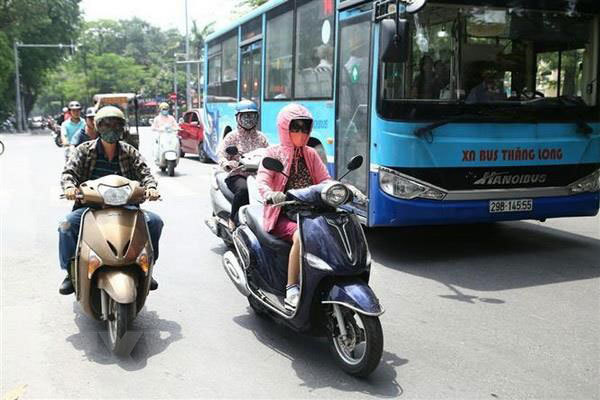 |
| The National Centre for Hydro-Meteorological Forecasting (NCHMF) yesterday warned of prolonged hot weather over the coming days.— VNA/VNS Photo Danh Lam |
Nguyen Van Huong, head of the Weather Forecast Division under the NCHMF, said that average temperatures this summer would be higher than previous years by 0.5-1 degree Celsius at 39-41 degree Celsius.
This month hot spells will occur much in northeastern provinces whereas in July and August, the hot spells will occur in central-northern and central provinces, said Huong.
“The prolonged hot weather not only harms people’s health with dehydration, exhaustion and stroke risks, but also affect socio-economic development,” said Huong.
To limit losses, the NCHMF will regularly provide weather updates to the press and steering committees for search and rescue, said Huong.
The ultraviolet (UV) warning indicator yesterday was from seven to 10 in Hanoi, HCM City and the central city of Da Nang, putting humans at high risk of harm.
Electricity operation
Scorching weather across the country in recent days has driven power consumption to a record high.
Power volume consumed on May 18 reached 756.9 million kWh following heat waves nationwide, mostly in the north and central regions, according to the Vietnam Electricity Group (EVN).
On May 17 this year, consumed power volume was 755 million kWh, beating last year’s high of 725 million kWh on July 3 last year.
In terms of power capacity, the maximum power output or peak power output hit 36,006MW, the highest-ever capacity in Vietnam, said Vu Xuan Khu, deputy head of the National Load Dispatch Centre (NLDC) under the EVN.
The EVN was under pressure to supply enough power, he said.
To have enough power for national consumption, the NLDC has mobilised power from different sources since April and nearly 100 solar power projects would be connected to the national grid before the end of this month, deputy general director of EVN Ngo Son Hai.
In addition, EVN plans to work with PetroVietnam Power Corporation and Vinacomin Power Corporation to utilise power from hydropower, coal-fired, gas-fueled, and diesel-fueled power plants to feed the economy, Hai said.
Forest fire risk
Authorities in north and central areas are setting up firebreaks, preparing equipment and putting up warning signs as the area’s forests face a high risk of fire in the dry season.
Quang Tri is one province at high risk.
Hoang Duy Quang, deputy director of the Ben Hai Protective Forest’s Management Board, said due to dry weather, forest fire risks were at their peak.
Additionally, local residents burn land for cultivation in this period, also causing forest fire risks.
To limit losses, the province has employed various preventive measures, including setting up inspector teams to patrol forests day and night.
Ha Sy Dong, deputy chairman of the Quang Tri People’s Committee, said that since the beginning of this year, the province delivered plans to prevent forest fires in each village.
Information and warnings about forest fires nationwide are updated regularly on the website kiemlam.gov.vn.
VNS
 The National Centre for Hydro-Meteorological Forecasting (NCHMF) yesterday warned of prolonged hot weather over the coming days." itemprop="description" />
The National Centre for Hydro-Meteorological Forecasting (NCHMF) yesterday warned of prolonged hot weather over the coming days." itemprop="description" />